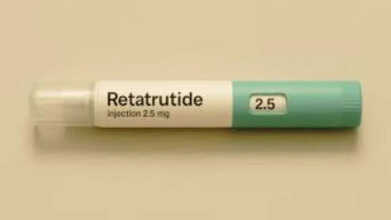- Health Conditions A-Z
- Health & Wellness
- Nutrition
- Fitness
- Health News
- Ayurveda
- Videos
- Medicine A-Z
- Parenting
Can You Use Anxiety To Your Benefit?

Credits: Canva
Anxiety is seen as an obstacle to success. It is a thought that always lingers in your mind before you start to do something. If you are doing something new or trying to do something that you have already done it in your life and have bad memories with. This thought creeps in. This thought that sometimes sends chills down your spine, makes you shiver, or that makes you feel like you cannot breathe, as if someone has put a huge rock on your heart is what defines anxiety. However, emerging research suggests that it can in fact, serve as a valuable tool for focus, motivation and problem solving. Studies on performance and stress, including the widely known Yerkes-Dodson curve, indicate that moderate levels of anxiety can enhance productivity, while both excessive and insufficient anxiety can hinder it.
The Yerkes-Dodson curve demonstrates that when anxiety is too high, it can become paralyzing, preventing individuals from taking action. On the other hand, very low anxiety can lead to complacency, reducing motivation and attention to detail. The ideal state falls somewhere in the middle, where anxiety signals importance, sharpens focus, and encourages preparation.
This perspective challenges the common belief that anxiety should always be suppressed. Instead, researchers argue that learning to harness anxiety can be beneficial. Studies have shown that people experiencing moderate anxiety often generate more creative solutions to problems compared to those who remain entirely calm.
How Can You Use Anxiety To Your Benefit?
Anxiety can serve as a sort of increased awareness, motivating people to take action in critical situations. Medical decision-making research show that concerned people are more likely to follow up on health issues, stick to treatment plans, and aggressively seek medical help. For example, studies on heart transplant patients show that people with moderate levels of anxiety are more likely to seek adequate care, which leads to improved survival rates.
The same strategy is used to address everyday difficulties. Anxiety tells the brain that something is important and requires effort. Anxiety can encourage you to be prepared and attentive, whether you're preparing for a presentation, making a critical life decision, or dealing with an uncertain situation.
Is There A Thin Line Between Anxiety That Helps And That Harms?
Despite its potential benefits, anxiety can become debilitating when it causes what researchers term “functional impairment.” This occurs when excessive worry prevents individuals from fulfilling their daily responsibilities, whether in work, relationships, or personal well-being.
One method for distinguishing between helpful and harmful anxiety is cognitive reframing—shifting the perspective on stressors. Studies suggest that those who reframe anxiety as a performance-enhancing tool rather than a hindrance experience less distress and greater effectiveness in high-pressure situations. By viewing anxiety as a source of energy rather than a threat, individuals can improve their ability to navigate challenges.
Research on stress resilience indicates that experiencing a moderate amount of adversity in life can lead to stronger coping skills. Longitudinal studies on both humans and animals suggest that those who have faced and overcome moderate difficulties—such as personal loss or professional setbacks—tend to develop greater mental fortitude.
One study found that individuals who had endured a small number of adverse events exhibited better overall mental health than those who had either faced extreme hardship or had led relatively stress-free lives. This pattern aligns with the concept of "stress inoculation," where manageable levels of stress act as a form of psychological training, making individuals more resilient to future challenges.
So, What Can You Do?
Rather than attempting to eliminate anxiety, researchers suggest acknowledging it as a natural response that can be channeled productively. Psychological studies indicate that when people view their physiological responses—such as increased heart rate and adrenaline surges—as performance enhancers, their actual outcomes improve.
For instance, in high-stakes situations like public speaking or athletic competitions, individuals who interpret nervousness as a sign of readiness rather than fear tend to perform better. Physiologically, the body's response to excitement and fear is similar; the key difference lies in perception.
Research suggests that those who embrace a mindset of "anxiety as fuel" experience improved cognitive and physical performance. This approach aligns with studies showing that moderate stress prompts the release of hormones that enhance alertness and problem-solving ability, whereas overwhelming stress triggers a flood of cortisol, which can impair decision-making.
Can A Cyst Grow Teeth And Hair Inside The Body? Everything You Need To Know About Dermoid Cysts

Credits: canva
A woman experiencing abdominal discomfort went to her gynecologist for an ultrasound, only to discover something far more startling than a baby. The mom, who shares her story on TikTok under the handle @sandwitchbread, revealed her medical surprise in a video that has now amassed over 1.9 million views. She said she had been struggling with pain and unusual bleeding since giving birth to her two-year-old son and decided to see a gynecologist fearing she might be pregnant again.
During the ultrasound, she noticed something on the screen, but the doctor quickly reassured her it wasn’t a baby. “When my doctor came in to share the results,” the TikToker recalled, “she looked me in the eyes and told me I had a seven-centimeter cyst, about the size of a chicken egg, called a dermoid cyst.”
What Is A Dermoid Cyst?
A dermoid cyst is a pocket of tissue growth that can contain normal body tissues, sometimes including hair, fluid, teeth, or skin. While this TikToker’s cyst was in her uterus, dermoid cysts are most commonly found in the ovaries. They are generally harmless but often require surgical removal. According to the National Cancer Institute, dermoid cysts are present from birth but may not be detected until later in life. These benign tumors originate from embryonic cells that become “trapped” and develop into tissues in the wrong location. Teeth and hair are frequent components, and surgery is usually recommended if the cyst causes symptoms or complications.
Why Do Dermoid Cysts Have Hair and Teeth?
Dermoid cysts develop hair and teeth because they arise from trapped embryonic cells (ectoderm) that can grow into skin, hair follicles, sweat glands, and even teeth, instead of forming the tissues normally found in the ovary or skin. Essentially, they are benign tumors made up of mature but misplaced body tissues from the outer layer of the embryo, which normally forms skin and related structures.
Dermoid Cysts: Symptoms
Most ovarian dermoid cysts remain symptom-free unless complications occur. When symptoms do appear, the most common one reported is lower abdominal pain.
As the cyst enlarges, it can cause noticeable abdominal swelling and problems with the urinary or digestive system.
In more severe cases, individuals might also experience:
- Fever
- Intense abdominal pain
- Unusual vaginal bleeding
- Unexplained weight loss
The Office on Women’s Health notes that cysts on the ovaries can also cause:
- Pressure in the abdomen
- Bloating
- Abdominal swelling
- Pain in the lower abdomen
Dermoid Cysts: Possible Complications
Some potential complications include:
Rupturing of the cyst: Though rare, ovarian dermoid cysts can burst. If the cyst’s contents leak into the abdominal cavity, it may lead to chronic inflammation of the abdominal lining (peritonitis). In some cases, leakage into the intestines or rectum can result in the material being expelled through the anus.
Ovarian torsion: This occurs when the cyst twists the ligaments holding the ovary in place, which can cut off blood supply to the ovary and fallopian tube.
Infection: The risk of infection is around 1–4%. Severe infections may lead to cyst rupture.
Malignant transformation: Dermoid cysts are almost always benign, but in rare instances, they can become cancerous.
Is Retatrutide The Next Weight-Loss Breakthrough After Ozempic And Mounjaro? Here’s How It Works Differently

Credits: Canva
A new weight-loss drug often described as the “triple G” treatment because it mimics three hormones linked to hunger and metabolism has delivered striking results in fresh data shared Thursday by its developer, Eli Lilly. In a clinical study involving more than 400 people living with obesity and knee osteoarthritis, the experimental drug retatrutide led to an average weight reduction of 71 pounds, or close to 29% of total body weight, over a period of 16 months, according to figures released by the company. Participants who received retatrutide also reported a 76% drop in knee pain by the end of the study period, based on the same data. So is
What Is Retatrutide?
Retatrutide is an experimental weight-loss drug developed by Eli Lilly and is widely seen as a next-step advancement beyond current GLP-1-based medications such as semaglutide and tirzepatide. While semaglutide acts on a single hormone pathway and tirzepatide works on two, retatrutide targets three.
It activates GLP-1 and GIP, along with an added glucagon pathway, which is why it is sometimes informally referred to as a “GLP-3” drug. Researchers believe this third pathway could explain the greater weight-loss effects seen so far, although retatrutide remains under investigation and has not yet received FDA approval.
Why Is Retatrutide Trending?
Even without regulatory approval, retatrutide has gained attention among gym enthusiasts, fitness creators, and online weight-loss communities. On platforms like TikTok, where direct searches for #reta or #retatrutide are restricted, users often refer to it using coded terms such as “ratatouille.”
At the same time, the drug has been in the news due to growing concerns about counterfeit versions. Reports from the UK recently revealed that authorities seized more than £250,000 worth of fake weight-loss injection pens labelled as tirzepatide and retatrutide from a hidden factory in Northampton. These products are especially concerning because retatrutide is still in clinical trials and has not been approved for use anywhere in the world.
How Is Retatrutide Different Than Other Weight-Loss Drugs?
Retatrutide works by mimicking three hormones that play a role in appetite and metabolism: GLP-1, GIP, and glucagon. In contrast, most weight-loss drugs currently available target only one or two of these pathways. Ozempic and Wegovy, made by Novo Nordisk, copy the effects of GLP-1, a hormone that influences the brain, pancreas, stomach, liver, and muscles, according to the National Institutes of Health.
Mounjaro and Zepbound, on the other hand, act on both GLP-1 and GIP, a hormone involved in blood sugar regulation through insulin stimulation. Retatrutide’s added glucagon effect is key, as glucagon is known to support fat burning, even when the body is at rest. Ozempic and Mounjaro are approved by the FDA for treating Type 2 diabetes, while Wegovy and Zepbound are approved for people with overweight or obesity. As with any prescription drug, it is important for individuals to consult a healthcare professional to determine whether these treatments are appropriate for them.
When Is Retatrutide Expected To Be Available To Consumers?
There is currently no confirmed timeline for when retatrutide might become available by prescription. Its launch will depend on the FDA’s detailed evaluation of clinical trial data once it is formally submitted. Based on current expectations, approval is unlikely before late 2026 and could potentially extend into 2027 or even 2028.
Nicotine Pouches: Are They Really A Safer Alternative To Smoking, Or Just Another Health Risk?

Credits: Canva
The use of nicotine pouches is rising sharply across the UK, especially among young adults, recent research suggests. These small pouches sit between the lip and gum and release nicotine gradually into the body. Available in many flavours, they often include sweeteners and plant-based fibres. But are they truly a better option than smoking, or could nicotine pouches still pose health risks? We take a closer look below.
What Are Nicotine Pouches?
Nicotine pouches are small, tobacco-free sachets that contain nicotine powder along with flavourings and fillers. They are placed between the lip and gum, similar to snus, allowing nicotine to be absorbed without smoke, vapour, or spitting. Marketed as a discreet way to consume nicotine, they still deliver a highly addictive substance and expose users to certain chemicals. Health experts have raised concerns, particularly for young people, despite these products often being promoted as a “safer” choice than cigarettes.
Popular brands such as Zyn, On!, and Velo now dominate a fast-growing market, according to the CDC. Like vaping, they do not contain tobacco and are generally viewed as less harmful than smoking.
A recent study led by researchers at University College London (UCL) found that over the past five years, about 522,000 additional people in the UK have started using nicotine pouches, with usage rising from 0.1% to 1% of the adult population.
This has raised an important question: are nicotine pouches actually safer than smoking, and what is driving their sudden popularity?
Nicotine Pouches: Is Using Them Safer Than Smoking?
Speaking on *Mornings with Ridge and Frost*, lead study author Dr Harry Tattan-Birch from UCL’s Institute of Epidemiology and Health Care told Sky News that the risks linked to nicotine pouches are much lower than those associated with smoking. “There’s no tobacco and no combustion,” he explained. “And we know it’s the burning of tobacco that causes most smoking-related diseases.”
That said, Dr Tattan-Birch and his colleagues stressed that these products are not harmless and should never be accessible to children. The NHS notes that while nicotine itself does not cause serious diseases in the way tobacco does, young people’s developing brains and lungs are more vulnerable to its effects, and dependency can form quickly.
UCL research fellow Eve Taylor also told Sky News that nicotine pouches are “far less harmful than smoking,” but cautioned that they are still relatively new. Because of this, their long-term effects are not yet fully understood. “We can look at what’s in them to estimate potential risks,” she said. “They’re not risk-free. Users are still exposed to some toxic substances, even if the levels are much lower.”
Nicotine Pouches: Are Pouches Helping People Quit Smoking?
According to UCL’s findings, among participants surveyed between January 2022 and March 2025, 69% of nicotine pouch users were also using other nicotine products. More than half of them, 56%, were still smoking cigarettes. Around one in six users, or 16%, reported that they had never been regular smokers, suggesting the habit was not linked to quitting cigarettes.
As quoted by Sky News, Dr Tattan-Birch said the public health impact of nicotine pouches depends largely on who is using them. “If a young person who might otherwise smoke switches to pouches, that could reduce harm,” he said. “But if someone who wouldn’t have used nicotine at all starts using them, the risk of harm goes up.”
Researchers added that more studies are needed to understand whether nicotine pouches genuinely help people stop smoking in the long run.
Are Nicotine Patches Harmful For Health?
Nicotine patches are widely regarded as safer than smoking and are a well-established aid for quitting. They provide a steady dose of nicotine to reduce cravings without exposing users to tar or cancer-causing chemicals found in cigarettes. However, they are not completely without side effects. Common issues include skin irritation, headaches, and sleep disturbances. People with serious heart conditions or those who are pregnant are advised to speak with a doctor before using them, as nicotine can still affect heart rate and blood pressure, though far less dangerously than smoking, according to the CDC.
© 2024 Bennett, Coleman & Company Limited

